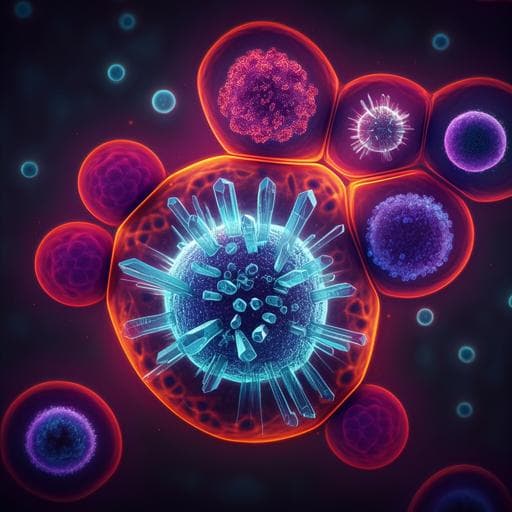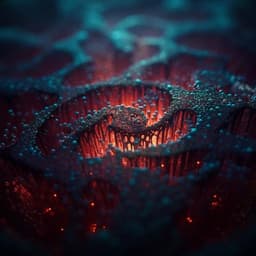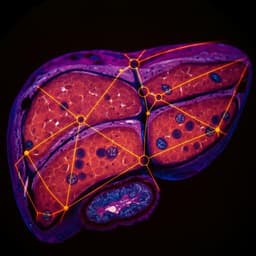
Medicine and Health
Rapid and stain-free quantification of viral plaque via lens-free holography and deep learning
T. Liu, Y. Li, et al.
This study by Tairan Liu and colleagues revolutionizes virology research with a stain-free plaque assay utilizing lens-free holographic imaging and deep learning, drastically reducing incubation times for important viruses like VSV, HSV-1, and EMCV. Discover how this innovative approach enhances clinical diagnostics and vaccine development!
~3 min • Beginner • English
Introduction
Viral infections cause major global health burdens, underscoring the need for accurate, low-cost virus quantification for diagnostics, vaccine development and antiviral production. The traditional plaque assay—developed in 1952 and still the gold standard—quantifies infectious virions as plaque-forming units (PFUs) but requires staining and long incubation times (2–14 days) and is prone to human counting errors. Many improvements have been proposed (e.g., immunofluorescence focus-forming assays, PCR, ELISA-based methods), yet they often require labels or specialized plates and still involve manual steps. Advances in quantitative phase imaging (QPI), holography, and deep learning present an opportunity to create a rapid, automated, label-free PFU assay. This study proposes a compact lens-free holographic imaging platform combined with a neural network to detect and quantify PFUs significantly earlier than traditional methods, without staining, and with increased dynamic range.
Literature Review
The authors review existing virus quantification approaches: traditional plaque assays, immunofluorescence-based focus-forming assays, PCR-based quantification, ELISA-based detection, and image-based automated counting systems. While effective, these methods generally require staining, labeling, longer incubation times, or specialized hardware, and remain susceptible to counting errors. Recent advances in QPI and holography enable non-invasive, label-free imaging of transparent biological specimens. Deep learning has improved phase retrieval, noise reduction, autofocusing, resolution enhancement, and microorganism detection/identification in QPI. These developments motivate a label-free, automated PFU detection framework that leverages spatiotemporal phase features with deep learning.
Methodology
Device and imaging: A compact lens-free holographic imaging system was built using three 515 nm green laser diodes (2 nm bandwidth) for coherent illumination, each illuminating two wells on a six-well plate. A CMOS image sensor (1.67 µm pixel size; ~0.3 cm² FOV) was positioned ~5 mm below the sample to capture in-line holograms. Mechanical raster scanning (two stepper motors, 21×20 positions with 15% overlap) acquired 420 holograms in ~3 min to cover a ~30 × 30 mm² active area per well. Cooling fans, parafilm sealing, and ventilation holes prevented sample heating and agarose drying. The entire hardware cost (excluding laptop) was <US$880.
Image pre-processing: Raw holograms were reconstructed via angular spectrum back-propagation with autofocus (Tamura-of-gradient) at each well’s center; a fixed propagation distance per well was used due to defocus tolerance. Phase images were stitched by correlation-based methods and linear blending. From the second time point onward, two-step registration (coarse whole-FOV correlation, followed by fine elastic registration) compensated stage inaccuracies.
Training data generation: For VSV, 54 training wells (45 positive, 9 negative) were imaged. A coarse PFU localization pipeline (temporal stacking, SVD background subtraction, bilateral filtering, naive Bayes pixel-wise classifier with multi-scale features and morphological operations) proposed PFU candidates at 12 h; these were reviewed by four experts via a custom GUI. Final VSV training set: 357 positive PFU videos and 1,169 negative videos, augmented to 2,594 positives and 3,028 negatives. Each video had four frames (480 × 480 pixels) with 1 h intervals. Negative data were drawn from negative control wells and included algorithmic false positives to improve specificity. Transfer learning datasets were similarly prepared for HSV-1 (1,058 positive videos from 122 PFUs; 1,453 negatives; 2 h intervals) and EMCV (776 positives from 152 PFUs; 1,875 negatives; 1 h intervals).
Neural network: A DenseNet-based classifier with pseudo-3D blocks processed four-frame phase videos to output PFU vs non-PFU probabilities. Training used weighted cross-entropy, ReLU, batch normalization, dropout (0.5), Adam optimizer (initial LR 1e−4; decay factor 0.7 every 30 epochs), batch size 30, for 264 epochs on an RTX3090 GPU. For HSV-1 and EMCV, transfer learning initialized from the VSV model; LR decayed by 0.8 every 10 epochs; training for 135 and 88 epochs, respectively.
Inference and post-processing: For testing, each well’s reconstructed and registered time-lapse phase images were scanned using a virtual 0.8 × 0.8 mm² window to produce a per-pixel PFU probability map over the whole well (~18,000 × 18,000 effective pixels). Processing took ~7.5 min per well. Applying a 0.5 probability threshold yielded a binary PFU detection mask. Post-processing included maximum probability projection along time and size thresholding (≥0.5 × 0.5 mm²). An automated PFU counting algorithm handled both sparse and dense samples by tracking connected components over time and taking the maximum number of components appearing in each region across time.
Sample preparation and assays: Vero E6 cells (~6.5 × 10^4 per well) were seeded in six-well plates and incubated 24 h to >95% confluency. Virus infection used VSV (diluted from 6.6 × 10^7 PFU ml^−1 stock), HSV-1, or EMCV; 2.5–3 ml agarose overlay (total medium with 4% agarose) was applied. For benchmarking, plates were further incubated (VSV 48 h, HSV-1 120 h, EMCV 72 h) and stained with crystal violet for traditional plaque assay ground truth. Time-lapse holography captured hourly (or bi-hourly for HSV-1) images during earlier incubation periods (e.g., first 20 h for VSV). A commercial BioTek Cytation 5 system with Gen5 software was used for automated PFU counting after staining for comparison under optimized settings.
Generalization tests: The VSV-trained model was directly applied to 12-well plates without retraining. Transfer learning adapted the model to HSV-1 and EMCV.
Key Findings
• The stain-free device detects the first VSV cell-lysing events as early as 5 h post incubation.
• For VSV, >90% PFU detection with 100% specificity was achieved in <20 h; specifically, at 20 h the detection rate was 93.7% with 0% false discovery rate (FDR). Earlier time points showed 80.1% (15 h) and 90.3% (17 h) detection rates (conservative due to ground truth defined at 48 h).
• Compared to a commercial automated counting system (BioTek Cytation 5 + Gen5) after 48 h and staining (94.3% detection, 1.2% FDR), the proposed method reached comparable detection (93.7%) with 0% FDR 28 h earlier (20 h).
• Transfer learning results: HSV-1—90.4% detection at 72 h with 0% false positives, reducing incubation by ~48 h compared to the 120 h traditional assay. EMCV—90.8% detection at 52 h with 0% false positives, saving ~20 h compared to the 72 h traditional assay.
• The method generalizes from six-well to 12-well plates without retraining, achieving 89% detection at 20 h for VSV.
• High-throughput, label-free, large-FOV imaging: ~0.32 gigapixels per scan per well over ~30 × 30 mm²; whole six-well plate scanned in ~3 min; per-well inference time ~7.5 min.
• Enhanced dynamic range: can accurately count PFUs at early stages even at high virus concentrations where traditional 48 h assays suffer from plaque clustering/overlap; reported ~10-fold larger dynamic range than standard assays.
• Robustness to artefacts: The network distinguishes true viral cytopathic effects from cell loss/viability artefacts via learned spatiotemporal phase signatures.
• Quantitative area readout: The infected area percentage monotonically decreases with increasing dilution factor at early time points (6–10 h), enabling calibration-based estimation of PFU concentration. In samples with infected area >1%, PFU concentration readout can be provided as early as 12–15 h (and ≤10 h for higher concentrations).
Discussion
Combining lens-free holographic time-lapse phase imaging with deep learning enables early, stain-free, automated PFU detection and quantification. The large field of view and digital focusing afford high information throughput within a compact, low-cost device suitable for standard incubators. The neural network exploits distinctive spatiotemporal phase signatures of PFU regions—broader phase distributions and larger temporal phase changes—to discriminate viral cytopathic effects from background fluctuations and artefacts, achieving high sensitivity without false positives and avoiding undercounting from plaque overlap. The reported detection rates are conservative because the ground truth is defined at later times (48/72/120 h), meaning many PFUs are not yet present physically at early imaging times. The approach also generalizes across plate formats and, with transfer learning, to different viruses (HSV-1, EMCV). Beyond counting, the infected area percentage provides a robust quantitative metric correlated with virus concentration, extending the dynamic range and enabling earlier readouts. The system shows resilience to incubator-induced variations (temperature, refractive index, bubbles) due to training on such variabilities. Potential improvements include parallelizing sensors to further increase throughput, improving mechanical stages to reduce registration needs, and enhancing phase recovery (e.g., multi-wavelength).
Conclusion
This work demonstrates a compact, cost-effective, stain-free viral plaque assay that leverages lens-free holography and deep learning to accelerate and automate PFU detection and quantification. It maintains the advantages of traditional plaque assays while substantially reducing incubation times (e.g., VSV detection >90% within 20 h at 100% specificity; HSV-1 and EMCV savings of ~48 h and ~20 h, respectively), expanding dynamic range, and providing robustness to artefacts. The framework also enables quantitative infected-area measurements that correlate with virus concentration, supporting earlier readouts. Future directions include parallel imaging modules to boost throughput, more precise stages to minimize preprocessing, multi-wavelength phase recovery to improve image quality, and adaptation to additional imaging modalities and virus types via transfer learning.
Limitations
• Ground truth is defined at later incubation times (48/72/120 h), so early-time detection metrics are conservative and reflect under-detection of plaques that did not yet exist physically.
• Mechanical scanning accuracy necessitates two-step image registration, adding computational steps.
• Model performance depends on sufficient training data; adapting to new virus types required transfer learning with curated datasets.
• Area-based concentration estimation requires calibration and can be affected by serial dilution errors, late plaque initiation, and clustering.
• Threshold selection (e.g., probability threshold 0.5, size thresholds) trades sensitivity and specificity.
• Pixel super-resolution was not used; while unnecessary for PFU detection here, it limits spatial resolution if finer morphological details were desired.
Related Publications
Explore these studies to deepen your understanding of the subject.







